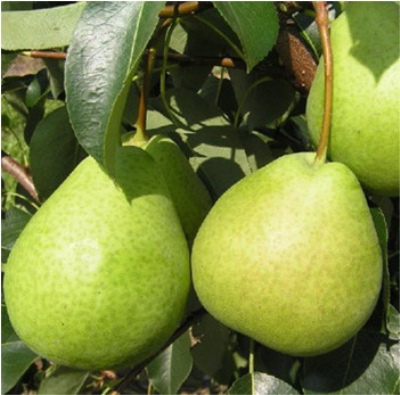
- Authors: folk selection
- Fruit weight, g: 100
- Ripening terms: summer
- Fruit picking time: In the end of August
- Appointment: dining room
- Growth type: vigorous
- Height, m: 6
- Crown: round, medium density
- Escapes: medium, curved, dark brown
- Leaves: medium, round, dark green, smooth, shiny, concave, leathery, medium thickness
Pear Limonka stands out favorably from the whole range of varieties of these fruit plants. Getting to know her is quite pleasant for any gardener. It is necessary to pay attention to all the basic properties of the culture and the peculiarities of its cultivation.
Description of the variety
Pear Limonka is one of the fruits of the so-called folk selection. This culture has a dining function and creates tall trees (up to 6 m). Their trunks are crowned with a rounded, moderately dense crown. The branches will branch off from the stem at an acute angle. They grow straight and are colored brown.
Shoots are bent. They reach medium length. Leaves of medium size are rounded. They are typically dark green in color and pronounced shine. The foliage surface is usually smooth.
Fruit characteristics
On average, pears Lemons weigh 100 g. These fruits are distinguished by their egg-like shape. It is not necessary to count on the large size of pears. The variety got its name, among other things, for their specific lemon-yellow color. The appearance of a blush is not typical for such pears.
Their other botanical features:
dry skin;
storage possibility up to 7 days;
an abundance of subcutaneous points on the entire surface;
short curved peduncle, colored in a light brown tone.
Taste qualities
The dry matter content in the Limonka pear reaches 19.1%. The proportion of sugars is 9.9%, and the inclusion of titratable acids is 0.17%. Despite this ratio, the fruit is characterized by a sour taste. Their flesh is quite firm.
Ripening and fruiting
Lemon is one of the summer varieties of pears. It will be possible to harvest the fruits approximately at the end of August. But sometimes these terms are shifted, both because of the weather and under the influence of agricultural technology. The first collection takes place 7-8 years after disembarkation. It must be remembered that pears can crumble before ripeness.

Yield
The number of fruits will be quite large. The exact figure is not named in the sources. But they assure that the collection will be stable.
Landing
Lemon is not too picky about development conditions. However, strict adherence to agrotechnical standards will prove to be very helpful. It is advisable to choose areas with loose soil, providing better aeration and water flow to the root system. Landing in spring or autumn is carried out on its own initiative. The roots are straightened very carefully, after which the dug soil of the upper layer is poured back, mixed in advance with mineral compositions and ash.
All this is desirable to tamp. The seedlings are tied up immediately. But you should not drag fragile specimens. The newly planted plant is watered using 20 liters of water. There are no more features.


Growing and care
Water this crop several times during the season. To prevent the water from spreading chaotically, you should dig narrow grooves, the width of which does not exceed 10-15 cm. Water should be poured slowly. Its consumption is 28-30 liters per 1 sq. m of the trunk circle. A special shelter for Limonka pears will not be required for the winter.
It is necessary to lay top dressing in a round trench. It is desirable to mix them with the ground. Of the mineral compositions, the use of potassium chloride is preferred. Urea and humus are recognized as the best organic fertilizers. When choosing between them, one must be guided by personal preferences.



Disease and pest resistance
Suppliers of planting material promise increased resistance to pathologies and insect pests. But still, the standard measures of protection and prevention will definitely not be superfluous. Instructions and precautions should be strictly followed.

Like any other fruit trees, the pear needs protection from various diseases and pests. When planting a pear on your site, you need to know in advance what diseases you should beware of. For a successful struggle, it is first necessary to correctly identify the cause of the problem. It is important to distinguish signs of disease from manifestations of the presence of insects, mites, caterpillars and other types of pests.
Resistance to soil and climatic conditions
The official description promises high winter hardiness and the ability to withstand harsh frost conditions. Heat resistance not described. However, gardeners should still closely monitor the condition of this plant in the event of unfavorable weather.
Review overview
In the reviews of farmers, it is noted that the Limonka pear is capable of producing excellent yields. The flavor of the fruit is unusual and different from what is usually accustomed to. It is worth considering that the trees are tall, and it can be difficult to harvest from them. At the same time, leaving is not too difficult. At least it makes sense to try such a culture.





































































